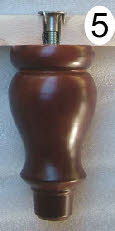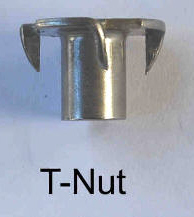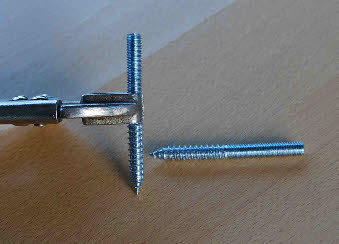A do-it-yourself guide from Edinburgh Woodturning - suppliers of high quality legs and bun feet for Sofas, chairs, beds, footstools and most furniture. www.edinburghwoodturning.com

Introduction
This page contains basic information about the fittings used for legs & feet including the use of Metric and Imperial dowel screws.
Nuts and Screws
Upholstered furniture with removable legs is usually manufactured with some type of retained fitting already positioned in the furniture frame. The most common fitting is a metal
T-Nut which has a machine thread into which the leg is screwed.
 The T-Nut is always fitted onto the TOP of the rail as shown in (5)
The T-Nut is always fitted onto the TOP of the rail as shown in (5)
The leg is screwed into the T-Nut from the
bottom of the rail and the metal prongs
grip the timber thus stopping the nut from
rotating.
When the leg is unscrewed, the T-Nut is retained in the wooden rail because the metal prongs have gripped the wooden rail. Be careful not to push the T-Nut upwards and “out” of the timber. It is easier to use this existing fitting where possible for new legs.
The leg removed will most probably have a (wood-to-metal) dowel screw protruding from the top. (some legs have a screw which goes right through from top to bottom but these are mainly found on legs with Brass Castors.)
One half of a dowel screw has a wood thread (with a point) and the other half has a machine thread as in the photo below:
![]()

If you have to remove a dowel screw then always grip it in the centre as shown, otherwise you might damage the thread. They are easily removed by turning anti-clockwise.
Over-Tighten ?
If you over-tighten a dowel screw it is possible that the timber fibres will be damaged, and the dowel screw will simply not grip the timber any longer. Do not despair. Just glue the dowel into the leg using a strong adhesive, but remember to remove any wood debris from the hole first.
We would recommend using Araldite because of its superior strength. Allow the glue to set fully before trying to re-fit the leg.
Metric or Imperial thread ?
Since there is no single standard thread used by all manufacturers, you will need to establish the screw diameter and thread type before buying new legs. The dowel diameter will normally be a choice of 8 mm, 10 mm or 5/16 inch Imperial.
Apart from the UK, European furniture has been virtually all metric for a long, long time. Within the UK, most furniture made since about 1990 will use Metric fixings and the leg dowel screw is most likely to be 8 mm diameter.
However, it is not possible to determine the type of thread just by measuring the dowel with a ruler. While Imperial 5/16 inch dowels almost measure the same diameter as Metric 8 mm , they are NOT interchangeable because the thread pitch is different.
In the UK some bed manufacturers still use Imperial 5/16 inch fittings.
The most reliable method is to get hold of a known 8 mm screw and check that it fits correctly. If it is the correct type, then it should fit without using any tools or force. (Buy a cheap 8 mm screw or bolt at B&Q or any good hardware store.)
Imperial screws are more difficult (but not impossible) to find in hardware stores in the UK but if you are reading this in the USA then it is most likely that your furniture will have Imperial 5/16 inch fittings. Make sure you check the dowel screw type before ordering.
It may be possible to simply phone the store from where the furniture was purchased and ask them what type of fittings are used on the furniture they sold you.
In the UK, some large items of modern furniture, mainly beds, use 10 mm diameter fittings. The same 10 mm fittings are also used on much of the furniture which comes from Sweden’s best known furniture manufacturer.
Dowel Screw Protrusion
Lastly, just be aware that dowel screws have various protrusions, normally ranging from 20 mm to 40 mm. Try to ensure your new dowel protrusion is similar to your existing legs. The dowels can be easily cut with a metal hacksaw but its better to buy the correct fittings. Long dowels can be a problem on beds and footstools in particular.
We supply our range of legs with 8 mm dowels fitted as standard and 35 mm standard protrusion. Our Bun Feet normally have a shorter dowel protrusion of 25 mm.
We can fit Metric 10 mm or Imperial 5/16 inch dowels on request to any of our new products
free-of-charge.